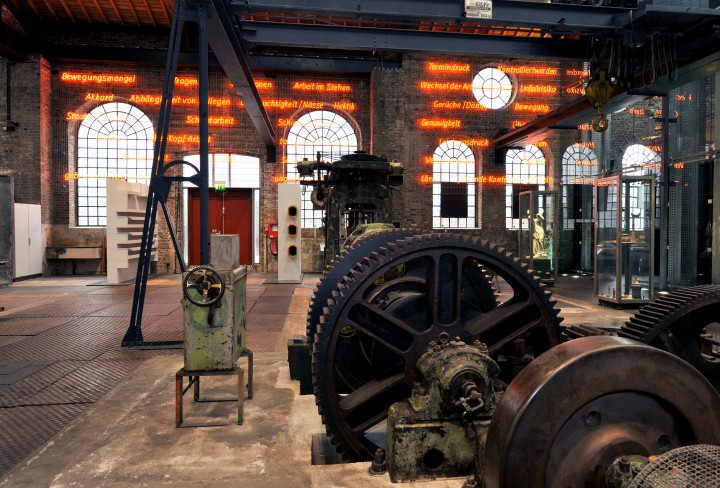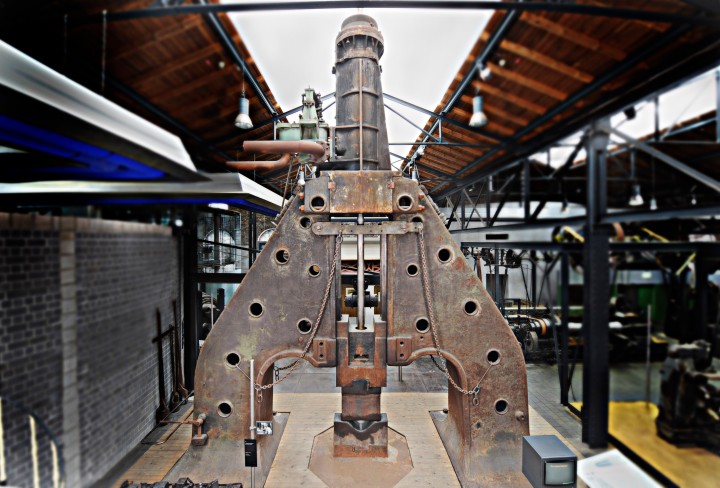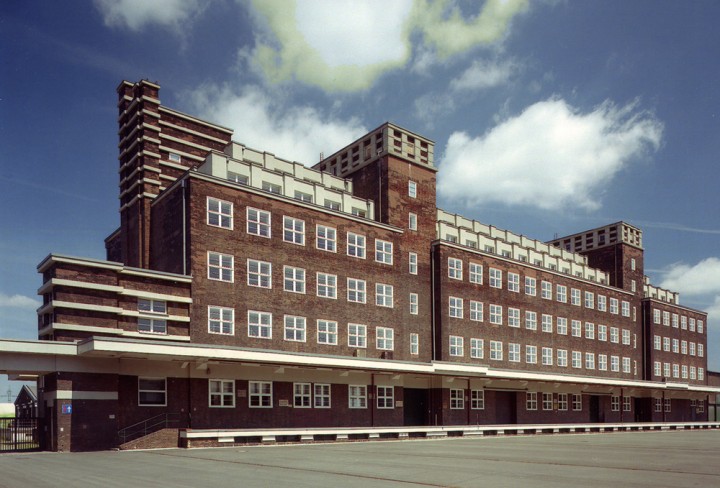Alle Standorte des LVR-Industriemuseums sind vom 23.12.2025 bis einschließlich 1.1.2026 geschlossen.

Oberhausen. Imposing steam engines, a steam hammer with almost 10 meters height, a huge locomotive and many other, mostly heavy weighing exhibits, as well as small and fine objects will meet the eyes of the visitors in the zinc factory Altenberg of the LVR-Industriemuseum. All of them revive the changing history of the iron and steel production in the Rhine and Ruhr area.
The permanent exhibition “heavy industries” is located in the rolling hall of the former zinc factory Altenberg, close to the main station Oberhausen. The entrance area welcomes the visitors with the remains of the old factory: a melting oven, circular casting equipment, and a roll framework. A unique way of object placement, historical film documents as well as multimedia and participation stations join the rest of the tour. The exhibition tells vividly about the origin of the iron and steel industry in the Ruhr area: about the deposits of ore and coal in the region, about stock and risky entrepreneurs, about the railway as the biggest consumer of iron and steel, which at the same time made transportation of people and supplies much easier, about inventors, who’s technical innovations revolutionized the production more than once. The guests stride through the inner part of a blast furnace. They can see detailed factory models, countless wheels, rails, chains and other products of the iron and steel industry. A powerful test, where steel is pulled apart, shows you how much load it can bear.
The iron and steel industry offered a multitude of different jobs. Three areas are introduced to the visitors of the museum: the foundry, the mechanical workshop and the forge. The dangers and forces were present at every workplace. The cast cleaners could lose their sight due to flying metal splinters, as the exhibited glass-eye shows. The huge steam hammer points out how much power was needed to forge steel. But expertise and a well working team were needed as well, so exact work could be delivered, as proved by the recordings of a real work-place.
The exhibition gives an inside to the changing relationships between heavy industries and politics. In times of war and armament, the economy of the Ruhr area benefited from the production of cannons, sheet metal for tanks and other armoury. Even “peaceful products” as the exhibited locomotive from the production series 50 by Krupp, which was build in 1942, could become evident for the war: it delivered war material to the front, pulled the deportation trains to the extermination camps, but it also helped with the reconstruction after the war. The living and working conditions of millions of forced labourers, without whom the production of the German industries would not have been possible during the Second World War, is depicted, as well.
After the Second World War the reconstruction of the economic organization made the Ruhr area flourish again during the economic miracle. But in the 1960s a long lasting crisis happened. The efforts for the structural change in the Ruhr area can be seen at the end of the exhibition: An Opel “Kadett” represents the settling of new industries in the area. So-called “tailored blanks”, made-to-measured sheet metals, show the new products of the steel industry. Models show new production innovations, with which the iron and steel industry wanted to stay competitive and a modern central control station explains how, with the ongoing process of automation of the production, the working places changed. Nowadays, the iron and steel industry of the Ruhr area focuses on the region around Duisburg, with production capacities similar to the ones in the good old times.
In 1981, the zinc factory Altenberg stopped its production. After the demolition of the plant, new flats and office buildings should have been build on the area of the former factory. But the city of Oberhausen changed its plans. In the rooms of the factory, a citizen’s centre was developed. A museum was part of the plan as well and in 1984, the LVR-Industriemuseum took over the main building of the factory. After the disposal of all environmental loads, the exhibition “heavy industries” opened in 1997.
An extensive education programme with interesting activities completes the offers of the museum. The LVR-Industriemuseum has regular held guided tours for adults and children in general, or focussed on special topics, whereas the topics go from the industrialisation or migration in the Ruhr area to the working conditions in the heavy industries. Children can participate in forging activities and learn how hard it is to form glowing iron. Also, children’s birthdays can be celebrated in the museum. A highlight every year in September is the historical Altenberg festival with a variety of programme for old and young, including participative activities, demonstrations, music and food. Furthermore, the museum offers an extensive range of guided tours and school projects with different key areas. All activities are supervised by trained guest guides.
Next to the museum in the zinc factory Altenberg, some other outstanding industrial monuments in Oberhausen belong to the LVR-Industriemuseum: The St. Antony-work is the birth-place of the Ruhr industry, for here the first pig iron of the Ruhr area flowed out of a blast furnace. Today, it tells about the thrilling beginning of the iron and steel industry, about significant innovations and about the hard life of the people, who worked there. Opposite of the museum in the LVR industrial-archaeological park, the former pulsating St. Antony-work is revived on an excavation site with roundabout 1000 square metres.
The museum Eisenheim in the oldest worker’s and colliery estate of the Ruhr area tells about the life of the worker’s families. The Peter-Behrens-Bau, a distinctive industrial building of the famous architect, was the main warehouse of the Gutehoffnungshütte (GHH) and is used as the main depository of the LVR-Industriemuseum with over 100.000 exhibits today. Nowadays, the shut down platform of the rails 4 and 5 at the main station Oberhausen is a museum and stages this place as the former place of trans-shipment for the heavy industries. Impressing pieces of art and a historical train are enlightened in the evening with beautiful and colourful spotlights.
The zinc factory Altenberg is one of a total of seven exhibition sites of the LVR-Industriemuseum, which combined, create a unique museum. In historical factories, of which some are listed for preservation, the history of the industry in the Rhineland and its workers is told in an interesting and illustrative way. The focus is put on metal, fabrics, paper and electricity, as the local branches. Apart from the zinc factory Altenberg the other museums are waiting to be explored: the Gesenkschmiede Hendrichs, the Papiermühle Alte Dombach in Bergisch Gladbach, the Kraftwerk Ermen & Engels in Engelskirchen, the Tuchfabrik Müller in Euskirchen, the Textilfabrik Cromford in Ratingen and the St. Antony-Hütte in Oberhausen. Furthermore, the museum’s headquarter with management, administration, depositories, library, photo archive and garages is placed in Oberhausen. Founder and bearer of the LVR-Industriemuseum is the Landschaftsverband Rheinland (LVR).
LVR-Industriemuseum
Zinkfabrik Altenberg
Hansastraße 20
46049 Oberhausen
kulturinfo rheinland
Tel.: 02234 / 9921-555 (Mon-Fri 8 am – 6 pm; Sat, Sun 10 am – 3 pm)
Fax: 02234/9921300
Mail: info@kulturinfo-rheinland.de
The following photographs are only to be used for editorial purposes in the context of coverage about the LVR-Industriemuseum and have to be marked with the copyright “©LVR-Industriemuseum”. Their printing is free of charge, but we would like to receive a specimen copy. The usage outside of this context is prohibited.

Exterior view of the historical zinc factory Altenberg of the LVR-Industriemuseum
© LVR-Industriemuseum

View into the foyer of the permanent exhibition “heavy industries” in the zinc factory Altenberg
© LVR-Industriemuseum

Steam hammer with a height of 10 meters in the permanent exhibition
© LVR-Industriemuseum

Exterior view of the Peter-Behrens-Bau, which contains the collection of the LVR-Industriemuseum
© LVR-Industriemuseum